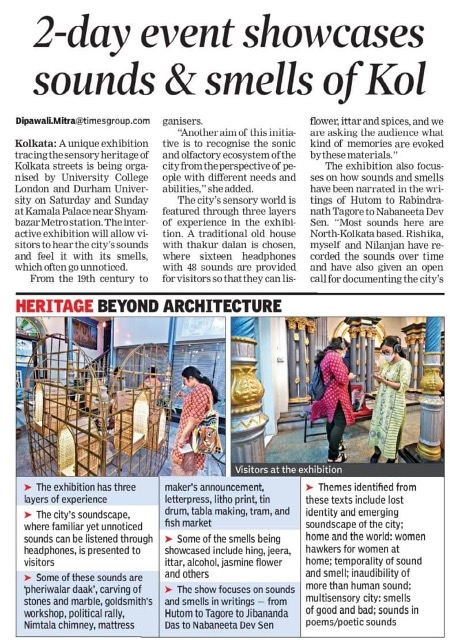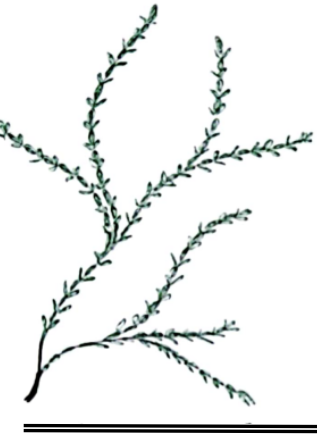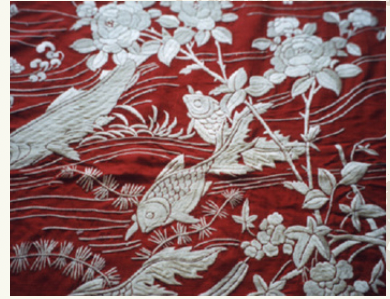By Rishika Mukhopadhyay and the team
“… দুপুর হতেই গলির মোড়ে শব্দ হল ঠংঠং বাসন চাই, বাসন?’ শব্দ চলে গেল দূরে। তারপরে এল চুড়ি চাই, খেলনা চাই?… সন্ধ্যাবেলার শব্দ হচ্ছে ওই বেলফুল। ‘বেলফুল চাই বেলফুল’ হাঁকতে হাঁকতে শব্দ গলির এদিক থেকে ওদিক চলে যায়।“
জোড়াসাঁকোর ধারে – অবনীন্দ্রনাথ ঠাকুর]
With the fall of the afternoon, a sound drifts forward from the corner of the lane, ‘anyone for utensils? Utensils anyone?’ – a characteristic metallic sound emanates from it and then it melts away in the far horizon! Then comes the bangle and the toy sellers…evenings are replete with swell-smelling Mogra sellers’ call- ‘Anyone wants Mogra?’ Their call travels from one end of the lane to another and slowly fades away.
Jorasankor dhare, Abanindranath Tagore

On the last Sunday of July 2022, as monsoon rain poured over North Kolkata streets, the team of Urban Sensory Heritage waded through the waterlogged street of Ramkanto Bose Street and managed to enter the imposing structure of Mullick family house. The yellow Corinthian columns had turned pale as they withstood the constant lashes of rain. The bamboo installation, the electric wires, switchboards, standing fans and hanging lights were steeped in water as the tarpaulin cover over the courtyard failed to keep off the rain from making its presence felt inside. Can we still continue with the exhibition on Kolkata’s sensory heritage? Will people still come on a rainy Sunday afternoon to hear the city’s everyday sounds and smell its familiar odours? Proving all our concerns wrong, around 300 visitors came from all corners of the city over two days 30-31 July. Our project Tracing Sensory Heritage of Kolkata Streets/ শহরের সংবেদন essentially wanted to bring art and heritage-related conversations in the city outside the gallery space and beyond the domain of experts.

This research and public engagement initiative proposes to look at Kolkata’s heritage as a constellation of overlapping and contesting modes of senses felt through sound and odours. The exhibition presented the city’s sensory world in three layers. First, we traced how sounds and smells of the city have been narrated in the writings of Hutom to Rabindranath Tagore to Nabanita Deb Sen. The writers and poets have captured how from the nineteenth century to contemporary times Kolkata’s urban sensorium has been an integral part of knowing, feeling and remembering the city.
Six themes have been identified from these texts. 1. Lost identity and emerging soundscape of the city / হারিয়ে যাওয়া ডাক এবং ডাকের বিবর্তন 2. Home and the world: Women hawkers for women at home/ অন্দরমহলের ফেরিওয়ালা 3. Temporality of sound and smell/ শব্দের সময় / শব্দেরসাময়িকতা 4. Inaudibility of more than human sound/ অশ্রুত জীবনের স্বর: প্রকৃতি এবং জীবজন্তু 5. Multisensory city- smells of good and bad মন্দ ভালোর বহু সংবেদনের মিশেল 6. Sounds in poem/poetic sounds কবিতায় মেলা শব্দেরা. Visitors were drawn towards these evocations and tried to find synergies between the century old texts and contemporary sounds.

Secondly, there was an invitation to listen to some familiar yet unnoticed sounds of the city which renders the city its identity and way of life. A call for participatory sound archive building was first circulated on social media to realise this vision. A joint effort of our team and members of the public captured around 50 sounds of the city spanning from the call of street hawkers to street making, from vehicles to announcements, from processions and sound of nature. The collection, which we would like to think of as sound commons of the city is available on Soundcloud. A soundmap of one neighbourhood of the city was made by Dr Sayantan Das. The display was interactive and visitors were curious to understand how the sounds can be integrated into Google Map.

Finally, an installation showcased the materialities of smell and perception of smelling good and bad. Bamboo craftsman Binod Pakrey from Dompara neighbourhood – a hub of bamboo craft, whose family has been engaged in this profession for generations worked with artist Nilanjan Das to give shape to the idea. The installation brought together two iconographies from Bengal’s architecture. The কুলুঙ্গি/ kulungi (a small nook carved within a wall to use as a shelve) can be seen in figure 4, nested inside an একচালা/ ekchala (a single arch which acts as an aureole during Durga Puja); they seamlessly blended with the existing architectural motif of the venue.
Spices, itar, flower, betel leaf as well as rotten fish, water from curdled milk and alcohol were kept hidden in eight brass jars of itar sprinkler. The audience was asked to identify the sounds and smells and reflect upon what kinds of memories are evoked by these materials. Further, they were remembering how the city is associated with these smells and sounds. Artist Nilanjan Das who curated the exhibition felt that the most difficult aspect of the exhibition was to capture the smell and make it accessible to people, precisely because of smells’ ephemeral nature. We received some valuable suggestions on smell capture from Dr Ishita Dey based at South Asian University in Delhi. Their month-long exhibition ‘Smells of the City: Scents, Stench and Stink’ commissioned by Kiran Nadar Exhibition of Art inspired us to work with containers that are available in our field site. Nilanjan chose brass itardaani(scent and rose water sprinkler) from Chitpur Road’s Zakaria street area for this purpose.


The overarching intention for this project is threefold. First, we are initiating an understanding of heritage in the city beyond the divide of tangible and intangible heritage and the lament of loss/destruction. Through the process of curating the exhibition and creating a participatory sound archive we also initiate public discussions around it. Second, through public engagement we democratise the heritage ‘making’ process that emerges from people’s attachment to their everyday atmosphere. Third, in the age of dominant visuality we are aiming to recognise the sonic and olfactory ecosystem of the city from the perspective of people with different needs and abilities. The public engagement and overwhelming response inspired us to take the project forward and we will wait for the city to call us back again.
Team members: Dr Raktim Ray (UCL, Development Planning Unit), Dr Rishika Mukhopadhyay (Durham, now Southampton Geography), Dr Sayantan Das (Dum Dum Motijheel College), Nilanjan Das (Rabindra Bharati University/Hamdasti), Suromita Kanjilal(Indus Valley world School)
Rishika has completed her PhD titled Heritagising Urban Craft Economy: Thinking with Chitpur Road Kolkata from Department of Geography, University of Exeter in 2021. During her time in Exeter, she was an active member of Exeter South Asia centre. She was part of the organising team for BASAS 2018 and PGR student workshop in July 2020. She continues to be involved with the centre and participates in the Decolonising South Asia reading workshop.
Funders: UCL Centre for Critical Heritage Studies and Durham University Geography Research Development Initiative

